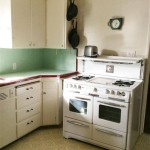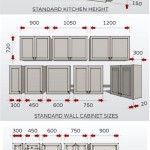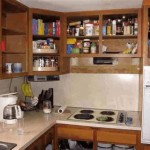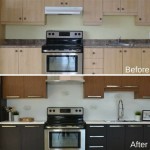Upper Kitchen Cabinet Width: A Comprehensive Guide
The width of upper kitchen cabinets is a crucial factor in creating a functional and aesthetically pleasing kitchen space. It directly impacts storage capacity, accessibility, and the overall visual balance of the room. Selecting the right cabinet width requires careful consideration of various factors, including the size of the kitchen, the layout, and personal storage preferences.
Standard Upper Kitchen Cabinet Widths
Upper kitchen cabinets typically come in standard widths, offering flexibility and ease of installation. The most common widths include:
- 12 inches: This narrow width is perfect for smaller spaces and areas where limited storage is needed. Ideal for tight corners, above sinks, or as accent cabinets.
- 15 inches: Another common size, offering a balance of storage and accessibility. Suitable for storing dishes, glassware, and kitchen tools.
- 18 inches: A versatile width that accommodates a wide range of items. Ideal for storing larger appliances like blenders or food processors.
- 24 inches: This wider width is ideal for maximizing storage space and offering ample room for larger items. Suitable for pantry cabinets or cabinets above the refrigerator.
- 30 inches: This is the widest standard size typically used for large storage needs. Excellent for storing bulk food items, appliances, or creating a pantry-like space.
It's crucial to consider the depth of the cabinets as well. Standard upper cabinets are typically 12" deep, but they can vary depending on the manufacturer. Deeper cabinets provide more storage space, but they can also make the kitchen feel smaller.
Factors to Consider When Choosing Upper Cabinet Width
When deciding on the appropriate upper cabinet widths, consider these factors:
1. Kitchen Size and Layout
The overall size and layout of the kitchen play a significant role in determining the appropriate cabinet widths. Smaller kitchens generally benefit from narrower cabinets to maintain a sense of spaciousness, while larger kitchens can accommodate wider cabinets for ample storage. Open concept kitchens might favor smaller cabinets to preserve an airy feel. Consider the flow of traffic and the placement of key appliances when deciding on cabinet widths to ensure ease of movement and accessibility.
2. Storage Needs and Usage Patterns
Evaluate your storage needs and how often you'll access items stored in upper cabinets. Frequently accessed items, such as dishes and glassware, might be better suited for narrower cabinets within easy reach, while less frequently used items can occupy wider cabinets placed higher up.
3. Ceiling Height
The height of your ceilings influences the optimal upper cabinet width. Higher ceilings allow for greater flexibility in choosing wider cabinets, as they won't feel overwhelming. Conversely, lower ceilings might benefit from narrower cabinets to avoid overcrowding the space.
4. Aesthetics and Visual Balance
Upper cabinets contribute to the overall aesthetic appeal of the kitchen. Consider the visual balance and proportion of the room when choosing widths. Consistent widths throughout the upper cabinets create a cohesive look, while varying widths can add visual interest. Be mindful of the relationship between upper cabinets and base cabinets, ensuring a harmonious and balanced design.
5. Cost and Availability
Standard cabinet widths often come with a lower price point and are readily available. Custom cabinet widths can offer greater flexibility in size and design, but they may be more expensive and require longer lead times. Weigh the benefits of custom widths against the costs and availability before making a decision.
6. Functionality and Accessibility
Prioritize ease of access and functionality when choosing upper cabinet widths. Consider the height of the cabinets and the ease of reaching items stored within. For tall ceilings, consider incorporating pull-down or lift-up mechanisms to make upper cabinets readily accessible.
By carefully considering the factors outlined above, you can select upper cabinet widths that optimize storage space, enhance accessibility, and elevate the overall aesthetic appeal of your kitchen.

Kitchen Cabinet Sizes What Are Standard Dimensions Of Cabinets

What Is The Standard Depth Of A Kitchen Cabinet Dimensions Cabinets Height Wall Units

Icymi Kitchen Cabinet Depth Dimensions Kitchencabinetsdimensions Upper Cabinets Wall

Kitchen Cabinet Depth 2024 Upper Cabinets Dimensions Wall
Guide To Kitchen Cabinet Sizes And Dimensions
Kitchen Renovation Size Requirements 1 Rona

Kitchen Design Symmetry Versus Functionality

3 Types Of Kitchen Cabinets Size Dimensions Guide Guilin

Kitchen Unit Sizes Cabinets Measurements Height Cabinet

N Standard Kitchen Dimensions Renomart
Related Posts








